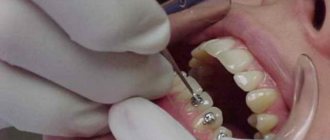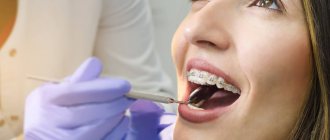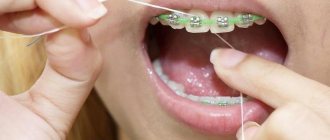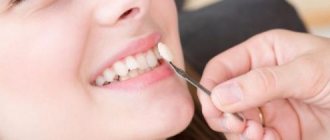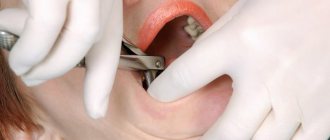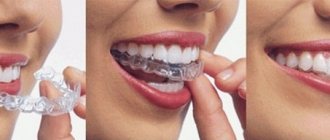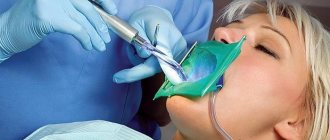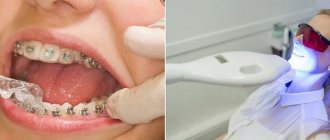Straight teeth are one of the essential components of a beautiful smile. However, a perfectly even position of teeth in a row is naturally rare; most often, in order to achieve high aesthetics and acquire a beautiful smile, the patient has to undergo long-term treatment, during which he wears special structures on his teeth - braces. Braces help align teeth in a row and eliminate unsightly gaps between teeth and crowding. Braces are also used to treat various malocclusions. The most thorough preparation is always carried out for treatment with braces, during which the optimal type of braces for installation is selected, a treatment plan is drawn up, and a decision is made on the need for tooth extraction.
Yes, it is a very real fact: sometimes one or more teeth need to be removed before installing braces. We will tell you why this is necessary in this article.
Calculate the cost of treatment by taking a short test in 20 seconds!
Do not delay your treatment, because in this matter time plays against us.
Briefly about braces
They are a system of individual locks and wires that connect them into a single arc. The clasps are fixed with glue on each dental unit. Then a wire is inserted into the grooves, which, in an effort to straighten, moves the teeth in the desired direction.
The brace system evenly distributes the load, eliminates pain when chewing food, reduces the risk of developing caries, diseases of the upper respiratory tract, oral cavity, and eliminates injuries to the cheeks and tongue from protruding elements.
The design does not violate the integrity of tissues, which is very important for preserving the beauty and health of teeth for many years.
Separation
There is an alternative method that can help avoid complex removal surgery. Separation is considered a more gentle way to free up space in the jaw row. Its essence lies in the fact that before installing a brace system, a specialist removes a small layer of enamel (no more than 0.25 mm) from the surface of one or several teeth. This does not affect the health of the unit in any way, but sensitivity may increase in the future.
This technology is simple and painless; the patient does not require long-term recovery, as after tooth extraction. Sometimes it happens that literally a few millimeters are not enough to correct the bite, then this method will be simply irreplaceable. In this case, tooth removal may free up too much space, which is also undesirable.
The main advantages of separation can be considered: reducing the risk of infection in the formed hole, eliminating the need for long-term rehabilitation and wound care. In addition, separation is performed quickly and painlessly; the patient does not need to undergo lengthy preparation or undergo many tests.
In what cases should teeth be removed?
As a rule, the bite is corrected in adolescence or adulthood, when the dental system has already formed. Before installing orthodontic braces, the patient undergoes a diagnosis by an orthodontist. The doctor identifies caries, concomitant diseases and abnormalities in the development of dental elements. All deviations are eliminated through treatment or removal. The exception is eights, which can erupt until they are 25 years old.
Teeth must be removed if:
- extensive carious cavities;
- cysts;
- root damage;
- strong swaying;
- osteomyelitis;
- chronic periodontitis;
- problems with figure eight teething.
A small jaw results in crooked or crowded teeth that do not fit in one row. In order to install the staples, you will have to remove the interfering elements.
Sometimes the size of the jaw does not match, which leads to disproportion of the oval of the face. After removal of teeth on a wider jaw and correction with braces, it is gradually leveled, normalizing facial proportions.
Extirpation is also done if there are too large or supernumerary elements.
Why remove teeth before starting orthodontic treatment and installing braces?
Why remove teeth before installing braces?
Patients ask this question to the doctor as soon as they hear about the need for this procedure. The answer to this is quite simple: in order for the teeth to align in a row and take the correct position, they must move in a certain way under the action of braces. But this shift requires not only a certain pressure created by braces, but also free space, which may not exist with severe crowding of teeth, with an abnormal jaw structure, or with the presence of extra teeth in a row. Then this space is created artificially and this is why teeth are removed. Sometimes tooth extraction before installing braces is indicated as a preparatory procedure for a course of correction.
Wearing braces complicates oral hygiene and increases the risk of developing a variety of dental diseases. These risks will be even higher if there are decayed teeth in the mouth, with inflammation in the root part. Such teeth must be treated before installing braces, and if this is not possible, then their removal is prescribed.
USEFUL TO KNOW: Removing a diseased tooth while wearing braces requires removing the structure from the teeth, and also leads to a significant increase in the overall treatment time!
What teeth can be removed when installing braces?
The main purpose of orthodontic braces is to correct the bite. For this reason, any dental units that are the cause of the anomaly or interfere with the installation of the braces system are removed.
The most common types of extirpation are the third molar (eighth), first premolar (fourth), and first molar (sixth). Less commonly, incisors or quints are removed. When determining an extra unit, the doctor tries not only to correct the bite, but also not to disturb the aesthetics of the dentition and the proportions of the face.
Wisdom teeth removal
Eights are removed or left according to indications, that is, this is not a mandatory procedure. Surgery on the extreme molar is complex, so it is not performed unless absolutely necessary. However, the doctor evaluates these dental units first.
Mandatory extirpation is carried out if:
- the third molar itself is the cause of malocclusion;
- there are inflammatory processes - pulpitis, periodontitis, pericoronitis;
- the outermost element is in the wrong position.
The number eight is difficult to care for, so it is often affected by caries. During eruption and growth, various complications can arise; it often puts pressure on neighboring units, displacing them. Some doctors perform removal as a preventative measure.
Removal of “fours”, “sixes” and other teeth
If it is necessary to remove healthy teeth, for example due to crowding, then the first premolars are removed. They have short roots, so the procedure is easier and safer. In addition, fours are less involved in the chewing process than others, so they will not greatly change the functionality of the dentition. Less commonly, fives and fangs are removed.
The first molars are removed less frequently, since removal is difficult, and the wound takes a long time to heal. Extraction of sevens is carried out only if the wisdom tooth is healthy, can accept the chewing load and serve as a support for braces.
Incisors and canines are rarely removed. Forced situations include severe destruction of the crown or root, advancement of the lower incisors forward (protruding lower jaw), and severe deviations in the size and shape of the elements.
Which dental units need to be removed largely depends on the type of bite pathology. Premolars are removed in case of cross or distal bite, lower incisors in case of mesial bite.
Free consultation on the cost of treatment in our dentistry
Leave a request and the clinic administrator will contact you within 15 minutes!
These teeth are often removed before installing braces to create free space in the rows. The fourth premolars have the shortest and smallest roots, so their removal is carried out quickly and without complications. In addition, these teeth bear less of the chewing load when eating food, and therefore their removal will cause much less harm to the health of patients than extraction of molars.
Removal of fifth premolars or “fives” before installing braces
They are removed before installing braces less often than eights and fours and usually when necessary, in order to obtain space for tooth displacement and preserve a maximum of chewing units.
The fifth premolars are larger in size than the fourth, however, the gap that remains after removing the “five” will not be noticeable either when smiling or when talking. Less commonly, teeth included in the smile zone, incisors, and seventh molars are removed before installing braces. Their removal before installing braces is carried out only if the patient has absolutely healthy wisdom teeth, which will be able to take on the entire load and efficiently perform the chewing function. Guessing which tooth may be removed in your case if you decide to install braces is generally useless. Firstly, this procedure may not be needed at all, and secondly, you need to take into account the malocclusion that needs to be eliminated. Only a specialist, an orthodontist, can assess the condition of your teeth, accurately determine bite defects and decide whether teeth need to be removed before installing braces. And not after one examination, but after a thorough and detailed diagnosis!
If you want to get advice from an experienced orthodontist on the treatment of malocclusion with braces, please contact our dental clinic in Moscow - Vanstom. To make an appointment with our specialists, you just need to dial the contact phone number of our dentistry or write to the chat on our website!
Tooth extraction before installing braces: how does this procedure affect the treatment time?
Correction of malocclusions with braces requires fairly long treatment periods.
Will this time be longer if you have to have teeth removed before getting braces? The answer to this question will be: in most cases, tooth extraction speeds up the course of treatment and allows you to wear braces less. After all, if there is free space in the row, the teeth will move and align faster. Calculate the cost of treatment by taking a short test in 20 seconds!
Do not delay your treatment, because in this matter time plays against us.
How quickly will a dental defect left after tooth extraction be closed? Patients also often ask dentists this question. On average, the gaps when wearing braces close at a rate of one millimeter per month, and therefore the smaller the tooth removed, the faster the defect will become invisible. It is worth considering that the rate of displacement of teeth in rows will also depend on the type of braces that will be used in the course of correction.
Is it possible to refuse tooth extraction and still undergo braces treatment?
In some cases, installing braces without first removing teeth will not allow the treatment to be effective and restore normal bite.
It is important to understand that in order for crooked teeth and crowding to disappear, the teeth must begin to shift and align. But these processes require free space in the dentition. If this place does not exist, there will be no result in treatment. Of course, the prospect of having teeth removed is not pleasant. But modern dentistry allows you to carry out this procedure without pain and quickly, and in addition, after completing treatment with braces, your teeth will become straight, beautiful, and the gap from the extracted tooth will be completely closed. This result is definitely worth some sacrifices!
You can find out more useful details about treatment with braces on the website of our dentistry in Moscow “Vanstom”: we have feature articles and news and, in addition, you can always ask our specialists a direct question by simply writing to us in the chat! You can also come to our clinic at any convenient time: we are located next to the Baumanskaya metro station and will always be happy to answer all your questions about treatment and maintaining dental health!
Is it possible to install braces without removing them?
Correcting a bite with a braces system comes down to moving the teeth in the right direction. If staples are installed without removing interfering elements, then orthopedic treatment will not bring the desired effect. For some types of pathology, structural features of the dental system and in childhood, extraction is not required.
An alternative to surgery is separation. It involves removing a layer of enamel from the side surfaces of the crowns. This way the required free space is achieved. The procedure is minimally invasive, does not require a recovery period, and does not cause pain or discomfort. The advisability of using this method should be discussed with your doctor.
Braces and wisdom teeth removal
On the Internet you can find a lot of information that before orthodontic treatment it is imperative to eliminate the eighth teeth. However, this statement is not entirely correct: “eights” are not always disposed of, but only in cases of extreme necessity. As a preventative measure, removing third molars is incorrect and even dangerous. Correctly erupted “eights” are the same part of the dentofacial apparatus as other teeth, provided, of course, that they have antagonists. Moreover, extracting the “eight” is not such an easy process.
Interesting fact!
In cases where there is clearly not enough space in the bone for the correct placement of teeth, specialists can remove the “eights” without waiting for them to erupt.
Nevertheless, when a patient is indicated for removal, experts pay attention to the wisdom teeth first - and here's why.
- They erupt later than others, between 16 and 27 years, which often negates the results of treatment carried out in adolescence.
- The process of their eruption is often associated with various complications (in about 75% of cases) - and this also affects the location of other teeth.
- “Wise” teeth sometimes remain impacted and do not participate in the bite, which makes them an unnecessary vestigial organ and a prime candidate for removal. However, there are situations when the patient simply does not have third molars or their extraction is not enough to correct the anomaly - in this case, it is necessary to resort to the removal of other teeth.
Cost of removal when installing braces
The price of the procedure consists of several indicators: the complexity of the surgical procedures, the duration of the operation, the number of elements removed, the type of anesthesia, and the cost of drugs. For example, extracting an incisor will cost less than a premolar and at least half as much as a figure eight. General anesthesia also increases the price of the service.
In our dental clinic, you can remove several teeth at once under sedation or anesthesia. This is an absolutely safe and painless treatment. We always strive to preserve the integrity of the dentition. We have dentists of various specializations who, in difficult cases, will hold a consultation to make the right decision. The cost of treatment and removal is discussed with the patient before the procedures begin.
Is it possible to avoid tooth extraction?
In order not to be faced with the choice of which tooth to remove and whether it is worth doing it, it is necessary to monitor the formation of the child’s bite from an early age. Many parents believe that they need to make an appointment with an orthodontist only when baby teeth are replaced by permanent teeth. This is an erroneous opinion: it is recommended to show the child to a specialist for the first time at the age of 2-3 years, so that the doctor can identify the prerequisites for the development of dental anomalies in time.
What do parents of young children need to pay attention to?
- On the child’s bad habits (constantly sucking his thumb, chewing on various objects, and will not part with his pacifier). Even improper bottle feeding can lead to underdeveloped jaws.
- Due to adenoids or frequent acute respiratory viral infections, the child adapts to improper (oral) breathing, and this negatively affects the condition of the entire dental system.
- Children sleep incorrectly (throw their heads back too far, put their fists under their cheeks, etc.). They don't watch their posture. All this prevents the correct formation of the dentition and the temporomandibular joint.
If these problems are addressed in a timely manner, then in the future there may be no need to remove healthy teeth that interfere with orthodontic correction. The orthodontist will prescribe myogymnastics and select vestibular plates and trainers. Treatment in adulthood, if carried out, will be more comfortable and take less time.
Before starting orthodontic treatment
The patient visited the orthodontist and received an initial consultation. At the consultation, the girl said that she had applied to other clinics, but everywhere she was offered to have her teeth removed to solve the problem. The patient did not like this approach, and she turned to O.A. Baranova after she learned from a friend that this doctor knows how to straighten crooked teeth without extraction. Since the patient agreed to undergo treatment, the orthodontist gave her a referral for in-depth diagnostics necessary for accurate planning.
After analyzing the in-depth diagnostic data (TRG images in frontal and lateral projections, OPTG, photographs, opinions of a dentist, psychologist and osteopath), the doctor prepared a treatment plan and presented it to the patient.
The orthodontist's diagnosis: crowding of the frontal group of teeth above and below, shortening of the upper and lower dentition, protrusion of the frontal upper teeth, displacement of the lower cosmetic center to the left, tentocclusion on the right, distal occlusion on the right.
According to the orthodontist, the size of the teeth is to blame for crowding (the jaws are of normal size). This way, treatment can be performed without having to remove teeth to create additional space. The solution to the space problem in this case will be separation - grinding off a thin layer of tooth enamel in the contact area.
The patient signed the treatment plan, choosing (with the help of the orthodontist) Incognito lingual braces during the discussion.
Customized Incognito braces, which are placed on the inside of the teeth, are an excellent choice for those who want to perform treatment without anyone noticing. And in combination with many years of experience O.A. Baranova’s treatment results will exceed all expectations, as she knows everything about Incognito braces!
Orthodontic treatment plan:
- taking high-precision impressions, ordering an individualized Incognito bracket system in Germany (approximate waiting period - 3 months);
- hygienic preparation of teeth, fixation of braces;
- slight movement of the teeth to gain access to the lateral surfaces of the teeth and carry out separation as carefully as possible - all calculations for separation (what thickness of enamel in fractions of a millimeter needs to be removed) are performed by the Incognito laboratory using computer modeling;
- separation of the upper and lower teeth - this stage is performed by the dentist;
- straightening teeth and closing gaps;
- creating physiological contacts between teeth using elastics;
- removal of braces, retention to stabilize treatment results.
Why do orthodontists sometimes remove healthy teeth?
Problem: in Family Dentistry to orthodontist O.I. Bolshova was contacted by the parents of a 13-year-old girl. Parents are concerned that the child’s front teeth stick out forward, the teeth grow crookedly, and on the lower jaw the permanent canine has begun to grow as a second row.
Solution: treatment with braces was carried out, after which the teeth became straight.
When there is a need for removal
Orthodontic treatment is required for patients who have a significant discrepancy between the sizes of teeth and jaws: for existing teeth of a certain size, there is simply not enough space on one, and sometimes on two jaws at once. Because of this, pathology of tooth placement develops:
- their crowding, manifested in partial overlap with each other;
- or protrusion - when narrower tooth roots fit on the jaw, and wide crowns can only stand straight if they protrude forward.
To restore the correct position of the teeth and eliminate the discrepancy in size with a “tight” jaw, dentists have to reduce the number of teeth before installing braces.
Is it possible to get braces without removing teeth ? It is possible, but in this case they can simply transform the problem of crowding into a problem of protrusion, and the aligned teeth, after removing the structure, will eventually return to their previous position.
The need to remove molars
Removal of wisdom teeth from the oral cavity is prescribed only if there is a possibility of a negative impact of these units on treatment.
Malocclusion associated with the location of eights cut or hidden in the gum, which shift adjacent units in such a way that the bite is disrupted and the upper jaw protrudes significantly beyond the lower jaw, is also considered an indication for surgery.
If the antagonist eights have not erupted, this is also considered an indication for the elimination of “extra” units.
Since molars are difficult to sanitize on their own, they are most often susceptible to chips, cracks, and destruction. It is not always advisable to treat figure eights, and this becomes another indication for extraction.
Premolar removal
Premolars are the teeth located behind the canines. There are 4 such units in each row. Premolars most often interfere with occlusion correction, so fours and fives are prime candidates for elimination.
X-rays are taken before extraction. This diagnosis helps to exclude the presence of deformation of the suture connecting the cranial bones.
Removal of incisors
Frontal units are subject to extraction if:
- the tooth is connected by bone tissue to the extra tooth;
- the incisors cut at the wrong angle;
- erupted front teeth are outside the dentition.
Sometimes it is impossible to correct the aesthetic parameters of a smile without removing the incisors. This happens if the crown is of irregular shape or is severely damaged.
How to avoid surgery
| Click to sign up for a FREE consultation |
If the deformation is minor, removal can be avoided. Slight crowding and expansion of the units allows you to correct the bite without extraction.
The absence of pathologies of the jaw bone also becomes the key to the preservation of all units of the dentition.
Is it possible to remove it if the braces system is already installed?
Note: It is advisable to carry out all preparatory procedures, including the removal of interfering teeth, before installing braces.
But the occurrence of a jaw injury and other situations when a braces system is already in place can lead to the need to remove the jaw organs when the structure is already installed.
In such a situation, the orthodontic arch is cut to the fangs, the molars are freed from the clasps and removal is performed. In this case, the bracket system continues its work in the same rhythm.
